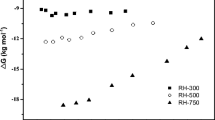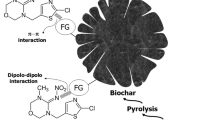Abstract
Biochar has been considered as a potential sorbent for removal of frequently detected pesticides in water. In the present study, modified and non-modified rice husk biochars were used for aqueous carbofuran removal. Rice husk biochars were produced at 300, 500, and 700 °C in slow pyrolysis and further exposed to steam activation. Biochars were physicochemically characterized using proximate, ultimate, FTIR methods and used to examine equilibrium and dynamic adsorption of carbofuran. Increasing pyrolysis temperature led to a decrease of biochar yield and increase of porosity, surface area, and adsorption capacities which were further enhanced by steam activation. Carbofuran adsorption was pH-dependant, and the maximum (161 mg g−1) occurred in the vicinity of pH 5, on steam-activated biochar produced at 700 °C. Freundlich model best fitted the sorption equilibrium data. Both chemisorption and physisorption interactions on heterogeneous adsorbent surface may involve in carbofuran adsorption. Langmuir kinetics could be applied to describe carbofuran adsorption in a fixed bed. A higher carbofuran volume was treated in a column bed by a steam-activated biochar versus non-activated biochars. Overall, steam-activated rice husk biochar can be highlighted as a promising low-cost sustainable material for aqueous carbofuran removal.




Similar content being viewed by others
References
Ahmad M, Lee SS, Dou X, Mohan D, Sung J-K, Yang JE, Ok YS (2012) Effects of pyrolysis temperature on soybean stover-and peanut shell-derived biochar properties and TCE adsorption in water. Bioresour Technol 118:536–544
Ahmad M et al. (2013) Trichloroethylene adsorption by pine needle biochars produced at various pyrolysis temperatures. Bioresour Technol 143:615–622
Altundogan HS, Arslan NE, Tumen F (2007) Copper removal from aqueous solutions by sugar beet pulp treated by NaOH and citric acid. J Hazard Mater 149:432–439
Al-Wabel MI, Al-Omran A, El-Naggar AH, Nadeem M, Usman AR (2013) Pyrolysis temperature induced changes in characteristics and chemical composition of biochar produced from conocarpus wastes. Bioresour Technol 131:374–379
Azargohar R, Dalai A (2008) Steam and KOH activation of biochar: experimental and modeling studies. Microporous Mesoporous Mater 110:413–421
Bermúdez-Couso A, Fernández-Calviño D, Pateiro-Moure M, Nóvoa-Muñoz JC, Simal-Gándara J, Arias-Estévez M (2011) Adsorption and desorption kinetics of carbofuran in acid soils. J Hazard Mater 190:159–167
Cely P, Tarquis A, Paz-Ferreiro J, Méndez A, Gascó G (2014) Factors driving the carbon mineralization priming effect in a sandy loam soil amended with different types of biochar. Solid Earth 5:585–594
Chang K-L, Lin J-H, Chen S-T (2011) Adsorption studies on the removal of pesticides (Carbofuran) using activated carbon from rice straw agricultural waste. World Acad Sci Eng Technol 76:348–351
Chen J-q, Hu Z-j, Ji R (2012) Removal of carbofuran from aqueous solution by orange peel. Desalin Water Treat 49:106–114
Chowdhury MAZ, Banik S, Uddin B, Moniruzzaman M, Karim N, Gan SH (2012) Organophosphorus and carbamate pesticide residues detected in water samples collected from paddy and vegetable fields of the Savar and Dhamrai Upazilas in Bangladesh. Int J Environ Res Public Health 9:3318–3329
DeZuane J (1997) Handbook of drinking water quality. John Wiley & Sons, New York
Dolphen R, Thiravetyan P (2011) Adsorption of melanoidins by chitin nanofibers. Chem Eng J 166:890–895
Foo K, Hameed BH (2010) An overview of dye removal via activated carbon adsorption process. Desalin Water Treat 19:255–274
Kundu S, Gupta A (2006) Arsenic adsorption onto iron oxide-coated cement (IOCC): regression analysis of equilibrium data with several isotherm models and their optimization. Chem Eng J 122:93–106
Lehmann J, Joseph S (2009) Biochar for environmental management: science and technology. Earthscan, London
Mahalakshmi M, Arabindoo B, Palanichamy M, Murugesan V (2007) Photocatalytic degradation of carbofuran using semiconductor oxides. J Hazard Mater 143:240–245
Makehelwala M, Weerasooriya R, Jayaratne L, Dissanayake C (2012) Thermodynamics of carbofuran adsorption on pyrite. J Chem Thermodyn 51:1–7
Mamindy-Pajany Y, Sayen S, Mosselmans JFW, Guillon E (2014) Copper, nickel and zinc speciation in a biosolid-amended soil: pH adsorption edge, μ-XRF and μ-XANES investigations. Environ Sci Technol 48:7237–7244
Masulili A, Utomo WH, Syechfani M (2010) Rice husk biochar for rice based cropping system in acid soil 1. The characteristics of rice husk biochar and its influence on the properties of acid sulfate soils and rice growth in West Kalimantan, Indonesia. J Agric Sci 2:39
Memon GZ, Bhanger M, Akhtar M (2007) The removal efficiency of chestnut shells for selected pesticides from aqueous solutions. J Colloid Interface Sci 315:33–40
Otieno PO, Lalah JO, Virani M, Jondiko IO, Schramm K-W (2010) Carbofuran and its toxic metabolites provide forensic evidence for Furadan exposure in vultures (Gyps africanus) in Kenya. Bull Environ Contam Toxicol 84:536–544
Öztürk N, Kavak D (2005) Adsorption of boron from aqueous solutions using fly ash: batch and column studies. J Hazard Mater 127:81–88
Rajapaksha AU, Vithanage M, Zhang M, Ahmad M, Mohan D, Chang SX, Ok YS (2014) Pyrolysis condition affected sulfamethazine sorption by tea waste biochars. Bioresour Technol 166:303–308
Rajapaksha AU et al. (2015) Enhanced sulfamethazine removal by steam-activated invasive plant-derived biochar. J Hazard Mater 290:43–50
Rao J, Viraraghavan T (2002) Biosorption of phenol from an aqueous solution by Aspergillus Niger biomass. Bioresour Technol 85:165–171
Remya N, Lin J-G (2011) Microwave-assisted carbofuran degradation in the presence of GAC, ZVI and H < sub > 2</sub > O < sub > 2</sub>: influence of reaction temperature and pH. Sep Purif Technol 76:244–252
Ryu SR, Noda I, Jung YM (2010) What is the origin of positional fluctuation of spectral features: true frequency shift or relative intensity changes of two overlapped bands? Appl Spectrosc 64:1017–1021
Sahoo S, Chakraborti C, Behera P, Mishra S (2012) FTIR and Raman spectroscopic investigations of a Norfloxacin/Carbopol934 Polymerie suspension. Journal of Young Pharmacists 4:138–145
Salman J, Hameed B (2010) Adsorption of 2, 4-dichlorophenoxyacetic acid and carbofuran pesticides onto granular activated carbon. Desalination 256:129–135
Shackley S et al. (2012) Sustainable gasification–biochar systems? A case-study of rice-husk gasification in Cambodia, part I: context, chemical properties, environmental and health and safety issues. Energy Policy 42:49–58
Shih YH, Wu SC (2004) Kinetics of toluene sorption and desorption in Ca-and Cu-montmorillonites investigated with Fourier transform infrared spectroscopy under two different levels of humidity. Environ Toxicol Chem 23:2061–2067
Siritham C, Thammakhet C, Thavarungkul P, Kanatharana P (2013) Online microchannel preconcentrator for carbofuran detection. Journal of Environmental Science and Health, Part B 48:893–905
Uchimiya M, Bannon DI, Wartelle LH (2012) Retention of heavy metals by carboxyl functional groups of biochars in small arms range soil. J Agric Food Chem 60:1798–1809
Vithanage M, Mayakaduwa S, Herath I, Ok YS, Mohan D (2016) Kinetics, thermodynamics and mechanistic studies of carbofuran removal using biochars from tea waste and rice husks. Chemosphere 150:781–789
WHO (2006) The world health report: 2006: working together for health. World Health Organization, Geneva
Xu Z, Cai J-g, Pan B-c (2013) Mathematically modeling fixed-bed adsorption in aqueous systems. Journal of Zhejiang University Science A 14:155–176
Zheng W, Guo M, Chow T, Bennett DN, Rajagopalan N (2010) Sorption properties of greenwaste biochar for two triazine pesticides. J Hazard Mater 181:121–126
Acknowledgments
This study is supported by MTR/TRD/AGR/3/1/8, Indo-Sri Lanka bilateral research grant sanctioned by the Ministry of Technology, Research and Atomic Energy, Sri Lanka and the Department of Science and Technology (DST), Government of India.
Author information
Authors and Affiliations
Corresponding author
Additional information
Responsible editor: Philippe Garrigues
Rights and permissions
About this article
Cite this article
Mayakaduwa, S., Herath, I., Ok, Y.S. et al. Insights into aqueous carbofuran removal by modified and non-modified rice husk biochars. Environ Sci Pollut Res 24, 22755–22763 (2017). https://doi.org/10.1007/s11356-016-7430-6
Received:
Accepted:
Published:
Issue Date:
DOI: https://doi.org/10.1007/s11356-016-7430-6




